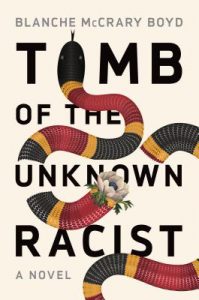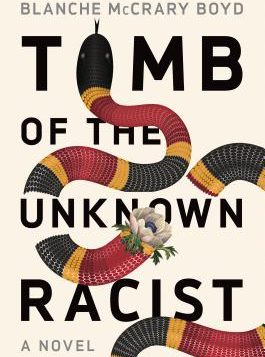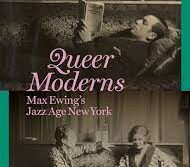 Tomb of the Unknown Racist
Tomb of the Unknown Racist
by Blanche McCrary Boyd
Counterpoint. 280 pages, $26.
A MYSTERY inside a character study masquerading as a sexual shell game, Tomb of the Unknown Racist, by Blanche McCrary Boyd, is byzantine, delightful, and terrifying. The novel’s who-done-it thread unwinds from South Carolina to New Mexico to Washington and back again, but it is the subject matter—which includes regionalism, the challenged American intellect, and White Power militants slithering Gollum-like to the surface of the melting pot—that makes us take notice. While the novel is raucous, funny, and intriguing, it has frightening echoes of the post-November 2016 zeitgeist.
The action kicks off with Wheel of Fortune. Ellen Burns, a Southerner, the novel’s lesbian narrator, is watching Pat Sajak and company with her daft, canny mother when a newsflash startles them. Two young children have been kidnapped from a New Mexico reservation, and their mother, much to Ellen’s astonishment, is her long-lost niece Ruby. Ruby’s father is Royce Burns, Ellen’s once-famous brother, presumed dead in an FBI shootout. Long ago, he authored a treasured novel, the type college students pass around and reread. He somehow morphed into a notorious white nationalist, who was for a time a protégé of the author of the Turner Diaries, that shoddy bit of fiction that has inspired marginally literate terrorists such as Timothy McVeigh. Apparently, Royce and the Turner guy had a falling out over the “issue” of Jews. Royce was opposed to slaughtering all Jews. Tomb of the Unknown Racist’s oddly specific details can be unnerving, but compelling. This family’s history is so complicated, and the complications so likely to be part of Ruby’s crisis, that Ellen flies to New Mexico to help her niece. She secures a hotel room, locates an AA meeting, and meets up with a local and manly cop, who assists her in her pursuit—and with whom she becomes involved. Despite the fact that Ellen has a fling with this policemen, and even if she occasionally has sex with other men, Boyd makes it clear that she identifies not as bisexual but as a lesbian pure and simple. This insistence on a hard-and-fast sexual orientation may cut against the current need to draw precise sexual distinctions, but Boyd presents it as an uncontroversial fact. Nevertheless, the author does seem to be inviting controversy when she writes: “If the FBI leaders thought Martin Luther King, Jr. was dangerous, can’t you imagine what they thought about radical lesbians.” I dragged that sentence from my apartment to the bodega on the corner and back, trying to dissect the message or attitude. King galvanized the nation and was hated and feared by the FBI. I know that lesbians, radical or otherwise, could be hated (and mocked), but I doubt that we were feared by the FBI as particularly dangerous. Were we? Ruby, the niece, is half Asian. Her boyfriend is a full-blooded Nogalu native whose mother is mistrustful of Ruby. It’s quickly revealed that everyone should be mistrustful of Ruby. As complicated as the story gets, Boyd keeps the reader hooked with her witty, evocative writing. Still in Charleston, Ellen settles her mother in bed, and notes: “Her hair was encased in a pair of white nylon underpants to preserve its shape. I had removed all of her makeup, including the lipstick on one eyelid. Either she had stopped with one eye because she sensed something was wrong or she simply got distracted.” Ellen’s increasingly senile mother inspires metaphors: “But if I look too long at her eyelashes they can start looking like a burned forest, or they can turn green and become a sugarcane field. I can smell it but I’m still sitting there taking off her eye shadow. Later, when I’m by myself, I can go back into the cane field because I like it there a lot.” When she returns from New Mexico, Ellen meets some dimwitted Charleston townswomen at the undertakers. Their understanding of theology and the church’s teachings on children in the afterlife would leave Aquinas speechless: “One of them told me quite seriously that although children are allowed to age in heaven, they have to max out at about ten or eleven, before puberty makes them crazy.” AA is essential to Ellen’s notions of theology and to a “higher power.” Her descriptions of meetings and the program in general are those of a grateful recoverer. A former boozer, she used any and all drugs—except heroin, a distinction she insists upon. In detailing the cumulative effect of her altered states, Ellen relates how her interaction with language, landscape, and imagination is forever changed: “Another thing that stays weird for me is metaphors. Metaphors become like real passageways in my head. I mean, metaphors can just be plain old metaphors, or they can make me feel as if I’ve stuck my arm in too deep and pulled out a living fish.” In the South, that’s called noodling, or so I learned from NPR: catching catfish barehanded. This isn’t a bad metaphor for many experiences: that of reaching into murky waters for something dimly seen, and slippery. And catfish can bite. So much happens in this beautifully rendered novel. The South comes to life in the way we have come to expect of Southern writers. Blanche Boyd does not overlook essential Southern themes—American themes, really—such as race and historical memory. Some mysteries are “cozies” in which a sweet lady detective pours lavender tea and reveals that the vicar did it. Tomb of the Unknown Racist is a not-cozy: sensibilities are not spared. The vigilant reader is thus rewarded.
Sarah Sarai is author of the poetry collections Geographies of Souland Taffeta and The Future Is Happy. She lives in New York.





